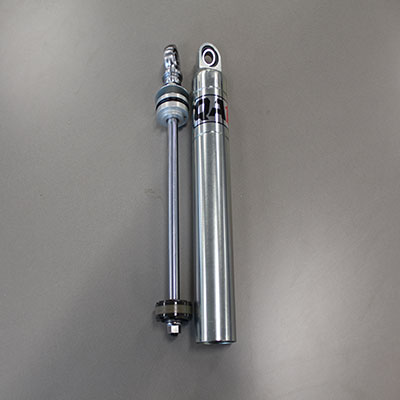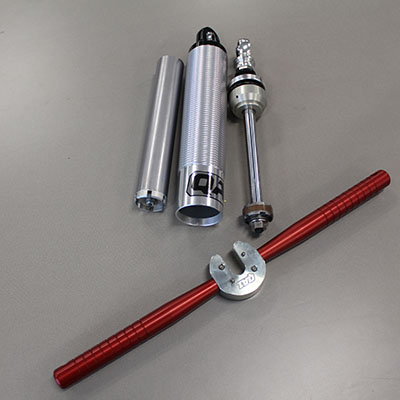TWIN TUBE VS MONOTUBE CIRCLE TRACK SHOCKS
Many people in the circle track world – whether you’re racing an asphalt bullring or sweeping dirt track – see shocks as the key to speed. And for good reason. While shocks are merely one part of your overall setup, they play a big role in the way your car handles and finds grip.
SHOP ALL QA1 CIRCLE TRACK SHOCKS
So what’s the difference between a monotube shock and a twin tube shock? When or why do you need one versus the other? Before we answer those questions, let’s cover a couple quick things.
First, shocks are ultimately a tuning device – not the end all, be all components that will win races. While they modify the way your car behaves, they won’t solve every problem. Many other important factors, from bar angles to ride heights to spring choices, play major roles in performance. Check with your chassis builder – or other trusted expert on your class or track – to make sure you have a solid overall setup.
Secondly, shock choices often come down to driver preference. If you’re an aggressive driver who loves a really free car, your shock setup will differ from someone who prefers a very snug, predictable car.
Now let’s get into the nitty gritty.
WHAT IS A MONOTUBE SHOCK?
Commonly called gas shocks, monotube shocks use a nitrogen charge. This gas is added via a port in the shock body. Some use a hyper screw while others use a Schrader valve, depending on your class and rules package. This charge means there is always pressure in the shock and the shaft floats on a cushion of gas.
The construction of the shock is right in the name. It is a single tube, and a floating piston rides directly against the body of the shock. This piston separates the nitrogen from the shock oil to keep it from foaming and becoming less effective.

WHAT IS A TWIN TUBE SHOCK?
A twin tube shock, which some call an oil shock or hydraulic shock, differs in construction and operation from a monotube shock. Instead of the piston riding directly against the outer body of the shock, there is a compression tube inside the shock body.
While a monotube shock uses nitrogen, a twin tube contains a sealed gas bag in the main body of the shock. As oil is displaced by the piston rod, it enters the shock body. The gas bag acts as displacement to ensure the oil is pressurized. This means the piston rod is not “floating” on a pocket of gas. Instead, the oil is forced through the piston and base valve.

IS ONE BETTER THAN THE OTHER?
Short answer? No. Monotube and twin tube shocks each have advantages and disadvantages. The choice often comes down to driver preference and driving style, as well as the racing surface and the car’s overall setup.
Monotubes are good on rough or bumpy tracks. This is because they react more quickly to changes in the surface. The nitrogen charge adds spring rate to the shock, meaning it extends faster than a twin tube. That same gas charge makes them more suitable for high-compression applications.
Monotube shocks can also be used to help add spring rate without over-springing a car. They’re often used when you want to “lift” a corner of the car or promote weight transfer. Many drivers will run a monotube on the left rear of their dirt cars. They can also be used on the front end of asphalt cars to keep them from bottoming out. All of those traits can be helpful. But that same gas pressure gives the driver less feel for the track. And the more that shock compresses, the more spring rate it has.
Last but not least, monotubes are much more likely to be taken out of commission by a small dent or ding in the body. Remember, the piston rides directly against the shock body and uses tight tolerances. It can easily get stuck against a dent, and possibly even seize up.
SO WHERE DO TWIN TUBES EXCEL?
Twin tube shocks are great in very smooth or dry slick conditions, as they provide more feel for the track. This is especially important when you’re fighting for traction. Twin tubes also offer more consistent valving through the whole range of travel because they don’t build spring rate or gas charge.
Twin tubes also perform well in high-rebound applications. This can help “tie down” the car. Many dirt racers will tie down the right front to help free the car up on entry. Asphalt racers may use them on both front corners to keep the front end from lifting off the track.
Because of their design, twin tubes can handle small dents and dings better than monotubes. So long as the compression tube is not deformed, the piston will still be able to move freely and keep the shock from seizing.
While that’s all great, twin tubes will not react to rough and rutty surfaces as quickly as monotube shocks. The lack of gas charge means they aren’t driven into the track in the same way.
HOW TO CHOOSE YOUR SHOCKS
Both twin tube and monotube shocks can be a great option for your circle track car. Our Tech Team can help you determine which is right for your car. We can also connect you to one of our rebuilders, who tune shocks for your exact needs and application.

